best seller
Here you will find ; ALL DOCUMENTS, PACKAGE DEALS, FLASHCARDS AND 100% REVISED & CORRECT STUDY MATERIALS GUARANTEED A+.
NB: ALWAYS WRITE A GOOD REVIEW WHEN YOU BUY MY DOCUMENTS.
ALSO, REFER YOUR COLLEGUES TO MY DOCUMENTS. ( Refer 3 and get 1 free document).
I AM AVAILABLE TO SERVE YOU AT ANY TIME
WISHING YOU SUCCESS IN YOUR STUDIES.
THANK YOU.
- 331
- 0
- 1
Community
- Followers
- Following
332 items
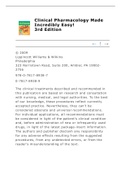
Fundamentals of clinical pharmacology
This chapter focuses on the fundamental principles of pharmacology. It discusses basic information, such as how drugs are named and how they’re created. It also discusses the different routes by which drugs can be administered. Kinetics, dynamics, therapeutics This chapter also discusses what happens when a drug enters the body. This involves three main areas: pharmacokinetics (the absorption, distribution, metabolism, and excretion of a drug) pharmacodynamics (the biochemical and physical ...
- Other
- • 982 pages •
This chapter focuses on the fundamental principles of pharmacology. It discusses basic information, such as how drugs are named and how they’re created. It also discusses the different routes by which drugs can be administered. Kinetics, dynamics, therapeutics This chapter also discusses what happens when a drug enters the body. This involves three main areas: pharmacokinetics (the absorption, distribution, metabolism, and excretion of a drug) pharmacodynamics (the biochemical and physical ...

CMY2604/1/2020–2024 70514437
Welcome to CMY2604! This is an extremely relevant module and we trust that you will fi nd it informative and stimulating. We are excited to embark on this journey through child adjudication with you. It is not always a clear and easy journey, but we have chosen an approach that aims to make this module as practical and relevant to you as possible. Dealing with children in confl ict with the law is a very diffi cult task, especially viewed in light of the fact that the treatment will have a per...
- Other
- • 109 pages •
Welcome to CMY2604! This is an extremely relevant module and we trust that you will fi nd it informative and stimulating. We are excited to embark on this journey through child adjudication with you. It is not always a clear and easy journey, but we have chosen an approach that aims to make this module as practical and relevant to you as possible. Dealing with children in confl ict with the law is a very diffi cult task, especially viewed in light of the fact that the treatment will have a per...

Organisational Communication Portfolio Examination
This paper will examine the role that organisational communication plays in the day to day operations of a business. Further on, different types of network channels will be reviewed so as to determine the various ways in which information flows. Besides this, the concept of conflict will be dissected to identify the forms of its occurrences. Additionally, the notion of communication technology will be assessed in terms of how it has transformed the face of business. Moreover, different manageria...
- Other
- • 28 pages •
This paper will examine the role that organisational communication plays in the day to day operations of a business. Further on, different types of network channels will be reviewed so as to determine the various ways in which information flows. Besides this, the concept of conflict will be dissected to identify the forms of its occurrences. Additionally, the notion of communication technology will be assessed in terms of how it has transformed the face of business. Moreover, different manageria...
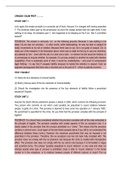
CRW2601 EXAM PREP
Let’s apply this simple principle to a concrete set of facts: Assume X is charged with having assaulted Y. The evidence relied upon by the prosecution to prove the charge reveals that one night while X was walking in his sleep, he trampled upon Y, who happened to be sleeping on the fl oor. Has X committed assault? FEEDBACK The answer is obviously “no”, on the following grounds: Because X was walking in his sleep, his act was not voluntary – in other words, while sleepwalking, he was n...
- Other
- • 16 pages •
Let’s apply this simple principle to a concrete set of facts: Assume X is charged with having assaulted Y. The evidence relied upon by the prosecution to prove the charge reveals that one night while X was walking in his sleep, he trampled upon Y, who happened to be sleeping on the fl oor. Has X committed assault? FEEDBACK The answer is obviously “no”, on the following grounds: Because X was walking in his sleep, his act was not voluntary – in other words, while sleepwalking, he was n...
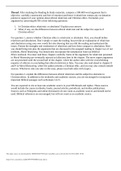
DB_Forum_1.docx
Explanation: 1. Taking into account the definitions and characteristics that the authors Esquivel (2004) and Martínez-Sáez (2008) present on the terms of relativistic and absolutist ethics, where it is extracted from this review that absolutism is when there are certain universal moral principles that are the basis for judging individuals and relativism is where there are no these absolute principles or moral values, so it follows that Christian ethics is absolutist because if there are univer...
- Other
- • 2 pages •
Explanation: 1. Taking into account the definitions and characteristics that the authors Esquivel (2004) and Martínez-Sáez (2008) present on the terms of relativistic and absolutist ethics, where it is extracted from this review that absolutism is when there are certain universal moral principles that are the basis for judging individuals and relativism is where there are no these absolute principles or moral values, so it follows that Christian ethics is absolutist because if there are univer...
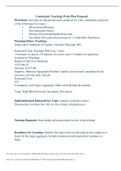
Community Teaching Work Plan Proposal
Learning Theory to Be Utilized: Explain how the theory will be applied. The teacher will educate the group about blood pressure and why it's important to maintained good pressure. She will ask everyone do they know what's a good bolo pressure and bad blood pressure. Ask the group who monitor their good pressure and daily and when should the report significant change in BP. She will have everyone demonstrated how to t...
- Other
- • 6 pages •
Learning Theory to Be Utilized: Explain how the theory will be applied. The teacher will educate the group about blood pressure and why it's important to maintained good pressure. She will ask everyone do they know what's a good bolo pressure and bad blood pressure. Ask the group who monitor their good pressure and daily and when should the report significant change in BP. She will have everyone demonstrated how to t...

Midterm Exam
You are viewing a graph that plots the NPVs of a project to various discount rates that could be applied to the project's cash flows. What is the name given to this graph? NPV Profile An investment offers a total return of 12.4 percent over the coming year. You believe the total real return will be only 9.7 percent. What do you believe the exact inflation rate will be for the next year? 2.46 percent The interest rate ...
- Exam (elaborations)
- • 4 pages •
You are viewing a graph that plots the NPVs of a project to various discount rates that could be applied to the project's cash flows. What is the name given to this graph? NPV Profile An investment offers a total return of 12.4 percent over the coming year. You believe the total real return will be only 9.7 percent. What do you believe the exact inflation rate will be for the next year? 2.46 percent The interest rate ...
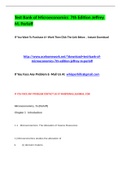
Test Bank of Microeconomics 7th Edition Jeffrey M. Perloff
.1 Microeconomics: The Allocation of Scarce Resources 1) Microeconomics studies the allocation of 1. A) decision makers. 2. B) scarce resources. 3. C) models. 4. D) unlimited resources. 2) Microeconomics is often called 1. A) price theory. 2. B) decision science. 3. C) scarcity. 4. D) resource theory. 3) Most microeconomic models assume that decision makers wish to 1. A) make themselves as well off as possible. 2. B) act selfishly. 3. C) make others as well off as possible. 4. D...
- Other
- • 898 pages •
.1 Microeconomics: The Allocation of Scarce Resources 1) Microeconomics studies the allocation of 1. A) decision makers. 2. B) scarce resources. 3. C) models. 4. D) unlimited resources. 2) Microeconomics is often called 1. A) price theory. 2. B) decision science. 3. C) scarcity. 4. D) resource theory. 3) Most microeconomic models assume that decision makers wish to 1. A) make themselves as well off as possible. 2. B) act selfishly. 3. C) make others as well off as possible. 4. D...
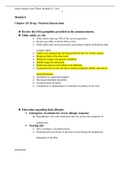
Module 6 Chapter 18: Drug –Nutrient Interactions
Review the FDA pamphlets provided in the announcements. Older adults at risk o Older adults make up 14% of the current population o By the year 2050, it will be 20% to 22% o Older adults take more prescription and nonprescription medications than younger adults o Likely to be taking drugs for long periods of time for chronic disease o Drugs are likely to be more toxic o Respond to drugs with greater variability o Handle drugs less efficiently o Nutritional status is more likely to be d...
- Other
- • 20 pages •
Review the FDA pamphlets provided in the announcements. Older adults at risk o Older adults make up 14% of the current population o By the year 2050, it will be 20% to 22% o Older adults take more prescription and nonprescription medications than younger adults o Likely to be taking drugs for long periods of time for chronic disease o Drugs are likely to be more toxic o Respond to drugs with greater variability o Handle drugs less efficiently o Nutritional status is more likely to be d...
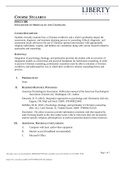
HSCO 506 INTEGRATION OF SPIRITUALITY AND COUNSELING
IV. MEASURABLE LEARNING OUTCOMES Upon successful completion of this course, the student will be able to: A. Integrate faith and spirituality in the counseling process where appropriate in an ethically competent manner. B. Develop a personal theory of integrative counseling that includes a rationale for the interdisciplinary application of counseling theories, faith, and spiritual principles. C. Assess client needs in an integrative pattern that is adapted to the client’s Christian religious or...
- Exam (elaborations)
- • 5 pages •
IV. MEASURABLE LEARNING OUTCOMES Upon successful completion of this course, the student will be able to: A. Integrate faith and spirituality in the counseling process where appropriate in an ethically competent manner. B. Develop a personal theory of integrative counseling that includes a rationale for the interdisciplinary application of counseling theories, faith, and spiritual principles. C. Assess client needs in an integrative pattern that is adapted to the client’s Christian religious or...
